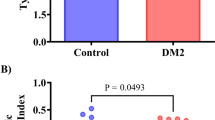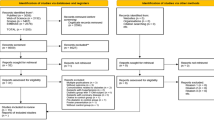Abstract
Despite few studies on intracellular heat shock protein70, the clinical association between insulin resistance and extracellular heat shock protein70 (eHSP70) is not well studied. In the current study, we examined the association between homeostatic model assessment-insulin resistance (HOMA-IR) and eHSP70 in patients with type 2 diabetes (T2DM) and healthy controls. A total of 145 patients with T2DM and 41 matched healthy controls were selected. Patients and controls were divided based on waist circumference (WC) to two groups, and eHSP70 was compared between them. The association between HOMA-IR and eHSP70 was examined using regression models adjusted for age, high-sensitive C-reactive protein (hs-CRP), and central obesity as confounding factors. While eHSP70 and hs-CRP were significantly correlated with HOMA-IR in patients with T2DM (p = 0.032, 0.025, respectively), there was no correlation between eHSP70 and HOMA-IR in the control group. Extracellular HSP70 and hs-CRP were not correlated in healthy controls. But a significant association appeared between eHSP70 and hs-CRP in patients with T2DM (p = 0.05). Both BMI and WC were not correlated with eHSP70 in both groups. Extracellular HSP70 was positively associated with HOMA-IR in patients with T2DM, independent from hs-CRP and obesity. We also showed eHSP70 levels remained unchanged through increase in BMI or WC in patients with T2D and in healthy controls. Our findings suggest that eHSP70 may contribute to the pathogenesis of T2DM by increasing insulin resistance.


Similar content being viewed by others
References
(2) Classification and diagnosis of diabetes. Diabetes Care. 2015;38 Suppl:S8–s16
Aguirre V, Werner ED, Giraud J, Lee YH, Shoelson SE, White MF (2002) Phosphorylation of Ser307 in insulin receptor substrate-1 blocks interactions with the insulin receptor and inhibits insulin action. J Biol Chem 277(2):1531–1537
Bruun JM, Lihn AS, Pedersen SB, Richelsen B (2005) Monocyte chemoattractant protein-1 release is higher in visceral than subcutaneous human adipose tissue (AT): implication of macrophages resident in the AT. J Clin Endocrinol Metab 90(4):2282–2289
Campisi J, Leem TH, Fleshner M (2003) Stress-induced extracellular Hsp72 is a functionally significant danger signal to the immune system. Cell Stress Chaperones 8(3):272–286
Chen L, Chen R (2015) Mechanisms linking inflammation to insulin resistance. 2015:508409
Chen Z, Yu R, Xiong Y, Du F, Zhu S (2017) A vicious circle between insulin resistance and inflammation in nonalcoholic fatty liver disease. Lipids Health Dis 16(1):203
Chichester L, Wylie AT, Craft S, Kavanagh K (2015) Muscle heat shock protein 70 predicts insulin resistance with aging. J Gerontol A Biol Sci Med Sci 70(2):155–162
Chung J, Nguyen AK, Henstridge DC, Holmes AG, Chan MH, Mesa JL et al (2008) HSP72 protects against obesity-induced insulin resistance. Proc Natl Acad Sci U S A 105(5):1739–1744
(2013) Effects of metformin, metformin plus rosiglitazone, and metformin plus lifestyle on insulin sensitivity and beta-cell function in TODAY. Diabetes Care 36(6):1749–1757
Dulin E, Garcia-Barreno P, Guisasola MC (2010) Extracellular heat shock protein 70 (HSPA1A) and classical vascular risk factors in a general population. Cell Stress Chaperones 15(6):929–937
Fontana L, Eagon JC, Trujillo ME, Scherer PE, Klein S (2007) Visceral fat adipokine secretion is associated with systemic inflammation in obese humans. Diabetes 56(4):1010–1013
Gerich JE (2000) Insulin resistance is not necessarily an essential component of type 2 diabetes. J Clin Endocrinol Metab 85(6):2113–2115
Hooper PL, Hooper PL (2009) Inflammation, heat shock proteins, and type 2 diabetes. Cell Stress Chaperones 14(2):113–115
Hotamisligil GS, Arner P, Caro JF, Atkinson RL, Spiegelman BM (1995) Increased adipose tissue expression of tumor necrosis factor-alpha in human obesity and insulin resistance. J Clin Invest 95(5):2409–2415
Islam A, Hait SH, Andrews-Shigaki B, Carus S, Deuster PA (2014) Plasma HSP70 levels correlate with health risk factors and insulin resistance in African American subjects. Exp Clin Endocrinol Diabetes 122(8):496–501
Krause M, Keane K, Rodrigues-Krause J, Crognale D, Egan B, De Vito G et al (2014) Elevated levels of extracellular heat-shock protein 72 (eHSP72) are positively correlated with insulin resistance in vivo and cause pancreatic beta-cell dysfunction and death in vitro. Clin Sci (Lond) 126(10):739–752
Lee YH, Giraud J, Davis RJ, White MF (2003) c-Jun N-terminal kinase (JNK) mediates feedback inhibition of the insulin signaling cascade. J Biol Chem 278(5):2896–2902
Mardan-Nik M, Pasdar A, Jamialahmadi K, Avan A, Mohebati M, Esmaily H, Biabangard-Zak A, Afzal Javan F, Rivandi M, Ferns GA, Ghayour-Mobarhan M (2016) Association of heat shock protein70-2 (HSP70-2) gene polymorphism with obesity. Ann Hum Biol 43(6):542–546
Mayer MP, Bukau B (2005) Hsp70 chaperones: cellular functions and molecular mechanism. Cell Mol Life Sci 62(6):670–684
Musi N, Hirshman MF, Nygren J, Svanfeldt M, Bavenholm P, Rooyackers O, Zhou G, Williamson JM, Ljunqvist O, Efendic S, Moller DE, Thorell A, Goodyear LJ (2002) Metformin increases AMP-activated protein kinase activity in skeletal muscle of subjects with type 2 diabetes. Diabetes 51(7):2074–2081
Najafizadeh SR, Ghazizadeh Z, Nargesi AA, Mahdavi M, Abtahi S, Mirmiranpour H, Nakhjavani M (2015) Analysis of serum heat shock protein 70 (HSPA1A) concentrations for diagnosis and disease activity monitoring in patients with rheumatoid arthritis. Cell Stress Chaperones 20(3):537–543
Nakhjavani M, Morteza A, Khajeali L, Esteghamati A, Khalilzadeh O, Asgarani F, Outeiro TF (2010) Increased serum HSP70 levels are associated with the duration of diabetes. Cell Stress Chaperones 15(6):959–964
Nakhjavani M, Morteza A, Asgarani F, Khalilzadeh O, Ghazizadeh Z, Bathaie SZ, Esteghamati A (2012) The dual behavior of heat shock protein 70 and asymmetric dimethylarginine in relation to serum CRP levels in type 2 diabetes. Gene 498(1):107–111
Nakhjavani M, Morteza A, Nargesi AA, Mostafavi E, Esteghamati A (2013) Appearance of leptin-HSP70 correlation, in type 2 diabetes. Meta Gene 1:1–7
Njemini R, Demanet C, Mets T (2004) Inflammatory status as an important determinant of heat shock protein 70 serum concentrations during aging. Biogerontology 5(1):31–38
Ohno Y, Yamada S, Sugiura T, Ohira Y, Yoshioka T, Goto K (2010) A possible role of NF-kappaB and HSP72 in skeletal muscle hypertrophy induced by heat stress in rats. Gen Physiol Biophys 29(3):234–242
Park HS, Lee JS, Huh SH, Seo JS, Choi EJ (2001) Hsp72 functions as a natural inhibitory protein of c-Jun N-terminal kinase. EMBO J 20(3):446–456
Prattichizzo F, De Nigris V, Spiga R, Mancuso E, La Sala L, Antonicelli R et al (2018) Inflammageing and metaflammation: the yin and yang of type 2 diabetes. Ageing Res Rev 41:1–17
Rahier J, Guiot Y, Goebbels RM, Sempoux C, Henquin JC (2008) Pancreatic beta-cell mass in European subjects with type 2 diabetes. Diabetes Obes Metab 10(Suppl 4):32–42
Rodrigues-Krause J, Krause M, O'Hagan C, De Vito G, Boreham C, Murphy C et al (2012) Divergence of intracellular and extracellular HSP72 in type 2 diabetes: does fat matter? Cell Stress Chaperones 17(3):293–302
Sawa T, Imamura T, Haruta T, Sasaoka T, Ishiki M, Takata Y, Takada Y, Morioka H, Ishihara H, Usui I, Kobayashi M (1996) Hsp70 family molecular chaperones and mutant insulin receptor: differential binding specificities of BiP and Hsp70/Hsc70 determines accumulation or degradation of insulin receptor. Biochem Biophys Res Commun 218(2):449–453
Vabulas RM, Ahmad-Nejad P, Ghose S, Kirschning CJ, Issels RD, Wagner H (2002) HSP70 as endogenous stimulus of the Toll/interleukin-1 receptor signal pathway. J Biol Chem 277(17):15107–15112
Wang X, Bao W, Liu J, Ouyang YY, Wang D, Rong S et al (2013) Inflammatory markers and risk of type 2 diabetes: a systematic review and meta-analysis. Diabetes Care 36(1):166–175
Yaglom JA, Gabai VL, Meriin AB, Mosser DD, Sherman MY (1999) The function of HSP72 in suppression of c-Jun N-terminal kinase activation can be dissociated from its role in prevention of protein damage. J Biol Chem 274(29):20223–20228
Acknowledgements
The authors wish to thank patients for their participation and kind cooperation.
Funding
This research did not receive any specific grant from funding agencies in the public, commercial, or not-for-profit sectors.
Author information
Authors and Affiliations
Contributions
The authors’ contributions are listed below:
• Conception or design of the work: Hamid Alemi, Pegah Khaloo, Manouchehr Nakhjavani
• Data analysis and interpretation: Mohammad Ali Mansournia, Hamid Alemi
• Drafting the article: Pegah Khaloo, Hamid Alemi, SoghraRabizadeh
• Critical revision of the article: ManouchehrNakhjavani, Hossein Mirmiranpour, Salome Sadat Salehi, Alireza Esteghamati
All the authors approved the final version and have the agreement to be accountable for all aspects of the work in ensuring that questions related to the accuracy or integrity of any part of the work are appropriately investigated and resolved.
Corresponding author
Ethics declarations
Conflict of interest
The authors declare that they have no conflict of interest.
Ethical approval
All procedures performed in studies involving human participants were in accordance with the ethical standards of the institutional and/or national research committee and with the 1964 Helsinki declaration and its later amendments or comparable ethical standards.
Rights and permissions
About this article
Cite this article
Alemi, H., Khaloo, P., Rabizadeh, S. et al. Association of extracellular heat shock protein 70 and insulin resistance in type 2 diabetes; independent of obesity and C-reactive protein. Cell Stress and Chaperones 24, 69–75 (2019). https://doi.org/10.1007/s12192-018-0942-x
Received:
Revised:
Accepted:
Published:
Issue Date:
DOI: https://doi.org/10.1007/s12192-018-0942-x




